
The UK economy shrank for a second straight month as companies and consumers struggled to bounce back from the blow dealt by US tariffs and a raft of tax increases.
Gross domestic product declined 0.1 percent in May after contracting 0.3 percent the previous month, the Office for National Statistics said on Friday. It was worse than the 0.1 percent increase forecast on average in a Bloomberg survey of economists.
The figures leave the economy at risk of stagnation over the second quarter, delivering a fresh setback to Prime Minister Keir Starmer and Chancellor of the Exchequer Rachel Reeves after a recent series of political knocks. The economy will contract over the second quarter as a whole if output falls by 0.4 percent or more in June, a sharp deterioration from the 0.7 percent growth in the first quarter.
The pound extended losses against the dollar after the data, dropping 0.3 percent to $1.3545. Bets on future interest-rate cuts were little changed with traders still leaning toward the Bank of England lowering borrowing costs again next month.
The Labour government is banking on stronger growth to help it fund its spending ambitions after recent U-turns on curbing welfare payments and winter fuel subsidies for pensioners made a difficult fiscal backdrop even tighter. In a statement, Reeves said the latest figures were “disappointing,” adding she is “determined to kickstart economic growth.”
She is caught between the need to placate jittery bond markets and soothe the concerns of her party’s lawmakers who want the chancellor to loosen the purse strings. There are fears that further tax rises in the autumn will weigh on an already anemic economy.
“The hangover of a very strong Q1-25 GDP print still hovers over the economy,” said Sanjay Raja, chief UK economist at Deutsche Bank. “This may take some time to unwind.”
ALSO READ: UK's Starmer, France's Macron to announce migration deal at summit
Manufacturing and construction fell the most in almost a year as weakness spilled over from “awful April” when output fell by the most in 18 months amid the pressures from US tariffs and a slew of cost increases facing households, from energy bills to property taxes.
Goods exports to the US struggled to bounce back from a sharp fall in April despite the Labour government sealing an agreement with Donald Trump’s US administration. They only rebounded by £300 million in May after falling £2 billion the previous month.
Services rose by just 0.1 percent with retailers being the largest drag on the sector in May. Consumer-facing services saw output tumble 1.2 percent, dampening hopes of a long-awaited revival in household spending. The damage was offset by strong growth in computer programming and other activities in the information and communication sector.
The first-quarter was boosted by exporters ramping up production ahead of expected US tariffs and homebuyers rushing to complete purchases before transaction taxes went up on April 1, which provided business for lawyers and estate agents.
ALSO READ: UK PM gives full backing to Reeves after tearful appearance in parliament
By contrast, the second quarter saw the economy face headwinds from trade disruptions, a £26 billion payroll tax raid on employers, inflation-busting hikes to regulated prices, such as rail fares and water bills, and increased stamp duty on home purchases. Employers, who are also grappling with a big rise in the minimum wage, have responded by cutting over 250,000 jobs since the October budget.
“May’s GDP data seems again to be affected by activity shifting around government policy, making it difficult to read underlying trends,” said Anna Leach, chief economist at the Institute of Directors. “The UK’s underlying growth is tepid and beset with risk.”
With inflationary pressures subsiding, money markets are betting the BOE will cut interest rates in August and again by the end of the year, with further reductions in 2026.


